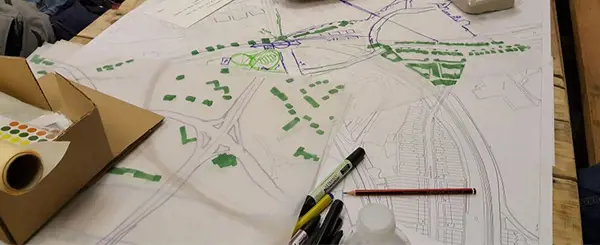On Saturday 24 September, a colleague and I joined over 60 architects, urban designers, planners and others in Cardiff Bay to envision how the proposed South Wales Metro could be a catalyst for transformation in the region. The “Metro Urban Density” (MUD) event, hosted by Design Circle, the southern branch of the Royal Society of Architects in Wales, offered an opportunity to consider how to maximise the benefits of several proposed stations in relation to the existing built and natural environment.
The day began with a site visit to a proposed Metro location, and during the afternoon each team brought its vision for a particular area to life through the use of maps, sketches, photos and models, before presenting its ideas to the whole group. The MUD team are working to compile the results of this work, and a report and accompanying film will be presented to decision-makers in order to illustrate the potential benefits of the Metro project.
As someone who lives in Newport and commutes to NLP’s Cardiff office every day, I already benefit from what is almost a “turn-up-and-go” rail service, at least during rush hour. Without this service, I simply would not choose to live where I do. If the same standard of service could be provided throughout South Wales, linking to key employment hubs including (but not limited to) Cardiff city centre, this could re-frame the way we think about travel in the area – making public transport a feasible, attractive option for commuting and leisure trips. It could also lead to new patterns of demand for homes, centred on Metro stops rather than motorway junctions.
One benefit of this potential shift in the geography of housing demand is that it could help to alleviate pressure on areas such as Cardiff, where supply is not keeping up with demand (as evidenced by its current housing land supply of only 3.8 years, just 8 months after the adoption of the Local Development Plan
[1]). The development of new homes can also bring substantial economic benefits to local communities. For every 10 new homes in Wales, approximately 10 temporary direct construction jobs are supported and £205,000 per annum is generated in resident expenditure
[2], some of which will help support local shops and services.
A recurring theme that emerged during the MUD workshop was the health and well-being benefits that a Metro could bring to communities, not only in terms of encouraging commuters to walk or cycle to stops but also through providing greater choice and accessibility to parks, leisure and recreation areas. The Metro could therefore help to promote a “healthier Wales” – a key component of the Well-being of Future Generations (Wales) Act 2015.
The South Wales Metro offers a unique opportunity to make a step change in the socio-economic future of the region, and a great hope for the project is that it will provide the driving spark for regeneration in the South Wales Valleys communities. However, we are under no illusions about the likely pitfalls and delays ahead. While the Metro should bring prosperity to the South Wales region as a whole, there will be winners and losers. Not every village and town will be able to have its own Metro stop, and deprived communities may have to wait longer to see the fruits of new investment. There is therefore a risk that, in addition to the challenge of funding the Metro, a lack of political support at the local level could serve to “de-rail” different elements of the project.
A key message from the MUD workshop was that the Metro needs champions. It particularly needs built environment professionals to stand up for a new vision of South Wales in the face of the challenges to come. It was heartening to see so many of these people at the MUD event (a big thank you to Design Circle for organising such an inspiring day). However, it will also need “practical people” and risk-takers who are willing to advance the Metro project step-by-step, recognising and responding to opportunities that arise as part of the development and planning process.



